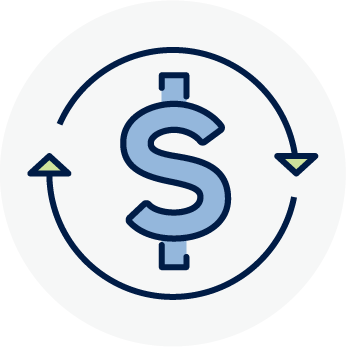An extra $50,000 can make a big difference in your life. Whether the extra cash came from saving pennies every month, a large bonus, the sale of property, life insurance proceeds, a tax refund, or an inheritance—it is incredibly important to treat that money as another investment opportunity and watch it grow.
While the immediate temptation might be to indulge in a luxurious vacation or buy that car you’ve always eyed, there’s something incredibly empowering about using that money to secure your financial future. Investing your money wisely can help it grow, providing you with more flexibility and security in the coming years.
$50K can go a long way—a long, long way. And we can show you how to make it go even further.
Let’s explore some of the best ways to invest $50,000 wisely.
Is Now the Right Time to Invest Your $50K?
Before diving headfirst into the world of investments, it’s crucial to pause and evaluate your current financial landscape. It’s like taking a moment to check the weather and lay out the appropriate gear before setting off on a hike—only this journey is about your financial future.
Not everyone’s situation is the same, and while $50,000 may seem like a golden ticket to greater wealth, investing might not be the most best choice for everyone at every moment.
Here’s how to determine if now’s the right time for you:
- Emergency Fund: Before thinking about investing, ensure you have an emergency fund covering three to six months of living expenses. Life is unpredictable, and having a cushion can provide peace of mind in the face of unexpected events like job loss, medical emergencies, or major home repairs.
- Existing Debt: Evaluate your current debts. High-interest debts, like those from credit cards, can erode your wealth faster than most investments can grow it. If your debt’s interest rate is significantly higher than the expected return from an investment, consider paying it down first.
- Insurance Coverage: Having adequate insurance (health, life, or property) is a safeguard against unforeseen financial shocks. Ensure you’re adequately protected to avoid potential financial pitfalls.
- Current Expenses vs. Income: Take a detailed look at your monthly expenses and compare them to your income. If you’re living paycheck to paycheck or struggling to manage expenses, it might be wise to allocate some of your $50,000 to alleviate financial stress.
- Future Financial Goals: Are there immediate or near-future financial obligations you need to cater to? Maybe a child’s education, a planned home purchase, or an upcoming wedding? If such expenses are on the horizon, tying up your funds in long-term investments might not be ideal.
- Risk Tolerance: Investing always comes with risks. Understanding your risk tolerance is vital. Are you okay with the idea of your investments potentially dropping in value in the short term for a potential long-term gain? Or does the idea keep you up at night? Your emotional and financial capacity to endure the ups and downs of the market should guide your investment choices.
The 5 Best Ways to Invest $50,000 in 2024
Now that you’ve paid down your debts, have a nest egg setup, and accounted for your risk tolerance, what’s next? The following 5 investments are not only some of the best ways to get a nice passive income stream going, but they also have proven to stand the test of time in even the most labile markets.
- Employer-Sponsored 401(k) Match
- Roth IRA
- 529 Plans
- Index Funds
- Real Estate
1. Employer-Sponsored 401(k) Match
Investing doesn’t always mean jumping into the stock market or purchasing real estate. Sometimes, the best investment opportunities are the ones right under our noses.
One such option (that many individuals overlook or undervalue) is the employer-sponsored 401(k) match. If you’re wondering where to start with your $50,000, here’s why this might be an excellent first step:
Employer Match
Many employers offer a match on 401(k) contributions as an employment benefit. Essentially, they will match your contribution up to a certain percentage. For example, if your employer offers a 100% match on the first 5% of your salary that you contribute, and you earn $60,000 annually, they’d contribute an additional $3,000 (5% of $60,000) if you also contribute at least that amount.
Why It Matters: This is essentially free money towards your retirement. Not taking advantage of this is akin to leaving a portion of your salary on the table.
Tax Advantages
401(k) contributions are typically made with pre-tax dollars, which means they can reduce your taxable income for the year. Additionally, the funds grow tax-deferred, meaning you won’t owe taxes on dividends, interest, or capital gains until you withdraw the money in retirement.
Why It Matters: This can make a significant difference in the growth of your investment over time due to the compounding effect. Your money can grow without the immediate drag of taxes, allowing it to accumulate faster.
Investment Choices
While 401(k) plans limit your investment options to those selected by your employer, they often offer a range of choices that cater to different risk profiles, including mutual funds that invest in stocks, bonds, and other assets.
Why It Matters: This allows you to diversify your portfolio within the confines of the 401(k) and select investment options that align with your financial goals and risk tolerance.
Considerations
While a 401(k) match is highly advantageous, be aware of potential pitfalls:
- Vesting Period: Some employers have a vesting schedule, meaning you only gain full ownership of the employer-matched funds after a specific period. It’s essential to understand your company’s policy if you’re considering changing jobs.
- Contribution Limits: There’s a yearly limit on how much you can contribute to a 401(k). As of my last update in 2021, the limit was $19,500 for those under 50 and $26,000 for those 50 and older, inclusive of catch-up contributions.
- Withdrawal Penalties: Withdrawing money from your 401(k) before age 59½ typically results in a 10% early withdrawal penalty on top of regular income taxes.
If you have $50,000 ready to invest and you haven’t maxed out your employer’s 401(k) match, it’s one of the first places you should start The combination of employer match, tax benefits, and potential for growth makes it a cornerstone of a wise investment strategy.
2. Roth IRA
Following the logic of employer-sponsored 401(k) plans, another powerful tool in your investment portfolio is the Roth Individual Retirement Account (IRA). While it might not come with the immediate allure of an employer match, its tax advantages and flexibility make it an excellent choice.
- Tax-Free Withdrawals: Contribute with post-tax money and enjoy tax-free withdrawals in retirement, benefiting those expecting higher future tax rates or brackets.
- No Required Minimum Distributions (RMDs): Offers greater flexibility for retirement and estate planning by eliminating mandatory distributions at a certain age.
- Flexibility in Withdrawals: You can access the money you contributed (not earnings) anytime without penalties, providing a safety net for unexpected financial needs.
- Considerations: Annual contribution limits are set at $6,500 (or $7,500 for those 50+ as of 2023), income restrictions may limit direct contributions, and while contributions can be withdrawn penalty-free, earnings have specific criteria for penalty-free withdrawal.
The combination of tax-free growth, flexibility in withdrawals, and no RMDs make it an attractive option for those planning a robust retirement strategy. However, given its contribution limits, a Roth IRA would be one part of a broader investment plan for your $50,000.
3. 529 Plans
When thinking about investing, it’s not just about retirement or immediate returns—it’s also about planning for future educational expenses. The major benefit of investing $50,000 in a 529 plan is that it allows your money to grow tax-free as your children grow.
This is where the 529 Plan shines as a remarkable investment tool:
- Tax Advantages: Contributions to a 529 Plan grow tax-deferred, and withdrawals for qualified educational expenses are tax-free at the federal level. Some states also offer tax breaks or deductions for residents who contribute.
- Versatility in Use: While designed primarily for higher education expenses like tuition, room, and board, recent changes have expanded the scope to include K-12 tuition and even student loan repayments (up to certain limits).
- High Contribution Limits: Unlike many other tax-advantaged accounts, 529 Plans often have very high lifetime contribution limits, sometimes exceeding $300,000 depending on the state.
- Considerations: Non-qualified withdrawals are subject to income tax and a 10% penalty on the earnings. Additionally, while contributions are post-tax at the federal level, there might be state-level tax benefits.
If educational expenses are on your horizon, allocating a portion of your $50,000 to a 529 Plan can be a forward-thinking investment move. With tax advantages and flexibility, it’s a strong tool for those prioritizing education in their financial planning.
4. Index Funds
For many investors, simplicity, diversification, and low costs are the holy trinity of investing strategy. Index funds capture all these attributes, making them a favorite among both new and seasoned investors.
Here’s why:
- Diversification: Index funds track a specific market index, such as the S&P 500. This means when you buy into an index fund, you’re effectively buying a small piece of every company in that index, spreading out risk and achieving instant diversification.
- Low Fees: Since they aim to mirror an index rather than beat it, index funds often have lower expense ratios compared to actively managed funds. This means more of your money stays invested and compounds over time.
- Historical Performance: While past performance is no guarantee of future results, over long periods, many index funds have outperformed their actively managed counterparts, mainly due to their low fees and broad market exposure.
- Considerations: While index funds offer broad market exposure, they move with the market. This means in a market downturn, the fund will reflect that decline. However, long-term investors often view these downturns as temporary and part of the natural market cycle.
Whether as a cornerstone of your portfolio or as a diversifying element, index funds offer a robust avenue for potential growth.
5. Real Estate
Real estate is one of the best ways to grow your wealth quickly. However, diversifying your investment strategies in real estate doesn’t necessarily mean purchasing properties. One less conventional but effective method is hard money lending.
Hard money lending allows you to invest in real estate without managing the properties yourself. This allows someone with decades of real estate experience to vet properties and borrowers without you having to understand the market.
Here’s what you need to know about investing your $50K wisely into hard money lending:
- What It Is: Hard money lending involves providing short-term loans to real estate investors, primarily for purchasing and rehabbing properties. These loans typically have higher interest rates than traditional bank loans due to the increased risk involved.
- Short-Term Gains: Given their short-term nature, hard money loans can provide faster returns on your investment compared to traditional real estate investments. Interest rates can range from 10% to 15% or even higher, depending on the perceived risk and local market conditions.
- Collateral-based: These loans are primarily based on the value of the property being financed, not the borrower’s creditworthiness. This means if the borrower defaults, the lender can take possession of and sell the property to recoup their investment.
Invest Your $50K Wisely With Yieldi
However, don’t just invest in any hard money lending business. At Yieldi, we’ve got over 50 years of family experience in real estate development focused on residential, commercial, mixed-use, fix/flips, multi-family, and lending. You can gain 9.5% or more on your investments without lifting a finger or dealing with a borrower yourself.
If you’re interested in learning more about hard money loans, check out Yieldi’s current offerings. Our online marketplace allows you to diversify your portfolio in one easy-to-use space.
See some of our current open offerings, here.


